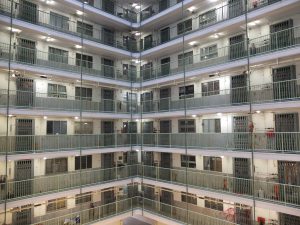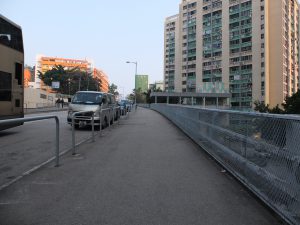STILL HUMAN, DIR. OLIVER CHAN (2019)
Inspired by real life event, Still Human is a poignant story of two strangers brought together by misfortunate fate. Cheong-wing, a paralyzed middle-aged man living alone in Oi Man Estate is confined to a wheel chair because of a fatal accident, hired Evelyn, a Filipino lady who dreamed of becoming a photographer, yet, cruel reality and an unsuccessful marriage forced her to give up on her dream and came to Hong Kong to make a living as a domestic worker. Despite difficult circumstances, the two developed a strong supportive bond and Cheong-wing’s pessimistic outlook on life was slowly impacted by Evelyn’s commitment on her dream. They both helped each other in realizing their dreams.
The major part of the movie was filmed in Oi Man Estate, where the director Oliver Chan grew up in. In her storytelling, Oi Man Estate carried a sense of stillness, almost as if it were a secluded village within a city. And atmosphere of the space is changed from cold to dark as Cheong-wing and Evelyn get closer. The movie begins with Cheong-wing going out to the hallway to escape drilling noise from his neighbour. However the overview camera angle depicts the twin tower light well design as a suffocating, dark and gloomy space, like a giant cage trapping Cheong-wing. While in real life, the light well actually brought sun light into its hallways and feels well ventilated. Kids were playing in the middle playground. The whole space feels energetic and lively opposed to the gloomy and suffocating atmosphere depicted in the movie.



The long path of Chung Hau street is also a critical narrative space in the film, it serves as the backbone that link different places together. In the film, this road is also a space of liberation rather than a regular pedestrian path. But what is it that make this path feels so liberating and free in the movie? Is it because of its length ? I think the key lies in how the actors inhabit this path in the movie. As Evelyn would often stand on Cheong-wing’s wheelchair and go at full speed, this action transformed the regular pedestrian path into a space of liberation for them. I think this aslo resonates with what Michel De Certeau states in his book that stories carry out a labor that constantly transforms places into spaces.


Still Human is a film about dreams. The dark and suffocating depiction of Sun Man House reflects Cheong-wing’s hopelessness but as Evelyn and Cheong-wing got closer, they became more optimistic and supportive of each other, at the same time, spaces in the film appeared to be more lively and poetic. For Instance, the upward shot of the light well with CGI to illustrate cheong-wing’s mental-image that he is flying towards the roof top. At the latter part of the film, the light well is no longer a cage but a cradle for their dreams. the atmosphere change from suffocating to liberating, dark to lively reflects Cheong-wing and Evelyn’s impact on each other’s attitude towards life.
Lai Kwong Ning, Max UID:3035795264
You made careful comparisons between that in the film and in reality, which helps you to understand the director’s style and decisions. You seem to put more effort into understanding the spaces and atmosphere in Oi Man Estate than Chung Hau Street. What kind of theoretical lens could you use to understand the site better? What if you also apply the concepts of ‘place’ and ‘space’ to understand the estate apart from the street? It would definitely add richness to your piece.